
The K-Pop Fandom on Twitter
K-Pop, also known as Korean pop, is a genre of popular music that originally emerged from South-Korea, but fans of this style of music can now be found all over the world. The K-Pop fandom differs from other fandoms on Twitter due to the fact that they have their own exclusive terms, traditions, and habits.. In this article I will look at K-Pop fans as a niched culture on Twitter.
The K-Pop fans as a social group
In Outsiders (1963), Howard Becker states that every group has different rules, norms and values and that the people who conform to these beliefs are seen as a part of this particular group. Due to the usage of certain terms, traditions, and customs that are exclusive to the K-Pop fandom on Twitter, K-Pop fans can be considered a social group or a niched culture.
Becker also discusses what the conditions and requirements are to be considered a member of a social group. You need to know the norms, the talk, the emblems, and the same applies to K-Pop fans on Twitter. There are many websites and blogs dedicated to helping new fans get into the fandom by teaching them about fan traditions, terms, and more.
In this article I will discuss the ways in which the K-Pop fandom differs from other fandoms on Twitter, and the ways in which you can show other Twitter users that you are part of the K-Pop fandom.
The analysis of the fans
For my research, I used an ethnographic approach. Ethnography is a method of doing research in which the researcher observes society andcultural phenomena from the perspective of the subject of the research (Varis, 2016). In particular, I committed to a digital ethnographic approach.
This type of research of course comes with all kinds of ethical considerations concerning the private lives of informants. When I wanted to incorporate someone’s tweet or picture, I always asked for their permission first. For more privacy, I removed their username and the actual text accompanying hashtags and pictures.
When I wanted to incorporate fans' Twitter profiles, I used pre-made profiles that I found on Tumblr, rather than social media profiles that were actually in use by real people, to respect people’s privacy as much as possible.
The K-Pop popularity
In the past year, the K-Pop fandom has grown tremendously on Twitter. K-Pop can be found in all the nooks and crannies on Twitter, but it does not stop there. Scroll through other social media platforms or turn on your television or radio and you will find K-Pop as well.
For example in the past year K-Pop group BTS has performed at many well-known Western award shows such as the Billboards Music Awards. The fact that K-Pop artists and groups are so present in the media enables the fandom to expand significantly, both online and offline.
In times of super-diversity (Vertovec, 2006), new media function as infrastructures that, among other things, create cultural niches. The same applies to the growth of the K-Pop fandom. Because K-Pop artists are becoming more popular in the media, and particularly in new media, new fandoms and thus cultural niches are born. The presence of K-Pop fans on social media platforms such as Twitter also contributes to the spread of K-Pop culture and thus helps strengthen the cultural niche.
The K-Pop language
One of the biggest ways in which the K-Pop fandom sets itself apart from other fandoms on Twitter is through the use of terms and names that are exclusive to this fandom. This can make it very difficult for new fans to integrate into the fandom. Because of this, there are blog posts and other web pages dedicated to explaining the different terms and rituals that are used by the fans to make it easier for people to understand what is going on in the fandom.
Terms such as bias, which indicates your favorite member of a K-Pop group, ult, which is considered your ultimate favorite idol of the K-Pop industry, and bias wrecker, which is the K-Pop idol that makes you doubt who is actually your favorite idol, are exclusively used in K-Pop fan culture and this terminology is only used when talking about K-Pop artists.
The utilization of these terms is one of the main reasons why K-Pop fans are considered to be their own cultural niche. Twitter users who do not belong to the K-Pop fandom do not use this language, or understand the terms.
The internet can help you gain experience with the language of a social group
To be considered a full member of the K-Pop fandom, you have to master the language that comes with it and understand and use the different terms that are part of the fandom (Becker, 1963). Due to the introduction of social media, it is now much easier to become a master of a language than before. For example, there are blog posts and websites that give definitions of all the terms. The internet can thus help you gain experience with the language of a social group.
These blog posts and web pages that explain the K-Pop language are mostly created by fans and, because of this, these established fans that master the lingo can be seen as “masters” or “crusaders” in the cultural niche. They have mastered the language and know all the norms and the talk. By writing these how to-posts, these crusaders try to help “newbies” of the fandom on their way to becoming connoisseurs themselves. Most of the time, these crusaders also have a relatively big following.
The profile
There are many ways in which you can show that you are part of a fandom on Twitter. The construction of one’s identity on Twitter involves displaying certain emblematic features that can be seen as typical for that identity. These features are arranged in a particular way and these necessary combinations of features make up one’s identity. Identity is thus a matter of “enoughness”. Hence, one has to have, display and enact “enough” of these emblematic features to be considered a part of a certain fandom (Maly & Varis, 2016).
One of the easiest and most forward ways to be considered a member of the K-Pop fandom on Twitter is by changing your profile picture and header to something K-Pop related. Basically everyone who considers themselves part of the K-Pop fandom on Twitter has a profile picture of their K-Pop idol with a matching header. What your profile looks like is thus an important index of your identity.

A fan-made profile for Twitter
In the making of a profile, it is particularly important to make sure that the profile picture and the header match in some way. This can be done by matching the colors, the background or the filter. In this example, you can see that the maker of the profile tried to make the profile match by using the same color in the profile picture and as in the header. I found this example on a Tumblr blog dedicated to making matching Twitter profiles for K-Pop fans.
The Selca Days
One of the many activities that is exclusive to the K-Pop fandom is the tradition of Selca Days. On these so called Selca Days, fans will post a picture of themselves with a picture of their favorite idol. The fans mostly post their Selca Days pictures on Twitter or Tumblr.
The idea of Selca Days is that you post these pictures of yourself and your idol with a specific hashtag for the Selca Day and every group of fans has their own specialized hashtag. For example, if you want to participate in the Selca Day for the fans of the K-Pop group BTS, you use the hashtag #ARMYSelcaDay.
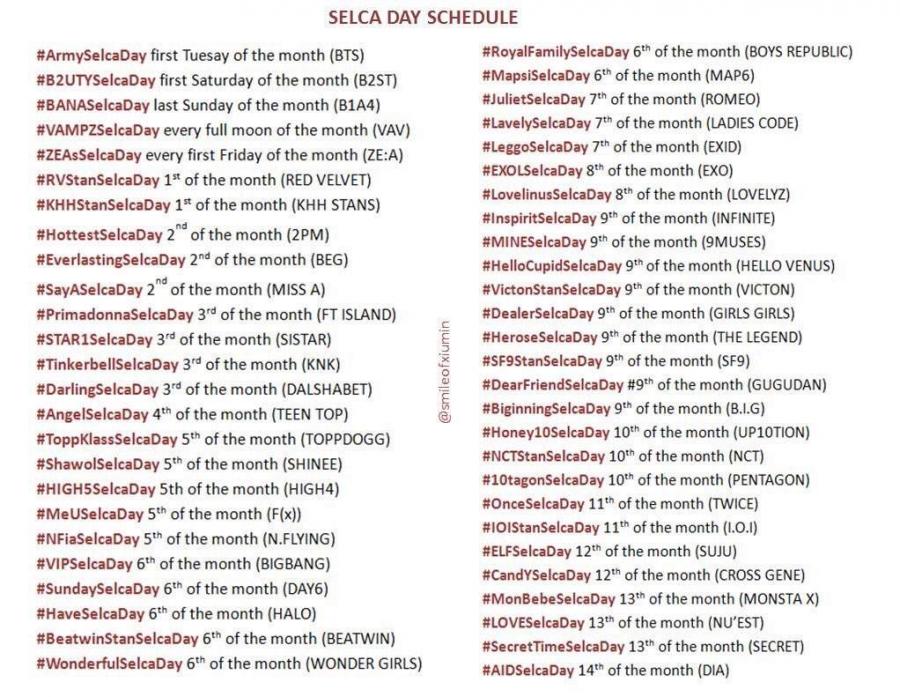
The schedule for the Selca Days
Additionally, there is a schedule made by a K-Pop fan on Twitter for when the Selca Day for certain fan groups will take place. For example, the selca day for BTS fans is every first tuesday of the month. The Selca Day for the fans of the K-Pop group Vav takes place on every full moon of the month with their hashtag #VAMPZSelcaDay.
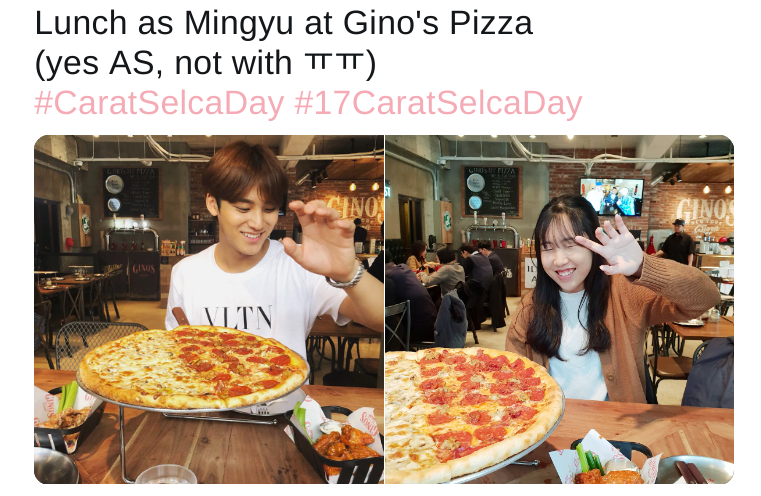
Example of a fan participating in a Selca Day
Further, most participants of Selca Days come up with a concept for their pictures to make them match. Participants of the Selca Days can do this by simply using the same filter, background, or pose as their idol.
They can also get a little more creative by trying to recreate everything from their idol’s picture, including the pose, background, and clothing, as you can see in the example. In the example, you can see that the fan tried to match the artist by using the same background, clothing, and pose. In the pictures, the idol and the fan are sitting in the same restaurant, eating the same pizza, wearing a white t-shirt and holding the same pose.
The threads
Another trend that is very big in the K-Pop fandom on Twitter is making threads of tweets to show your love and support for your favorite idol. Many fans make a thread called “365 days with your ultimate”, in which they tweet a picture of their favorite artist every day for 365 or more days straight. There are even fans who have been keeping up their thread of pictures of their idols for over 3 years now.
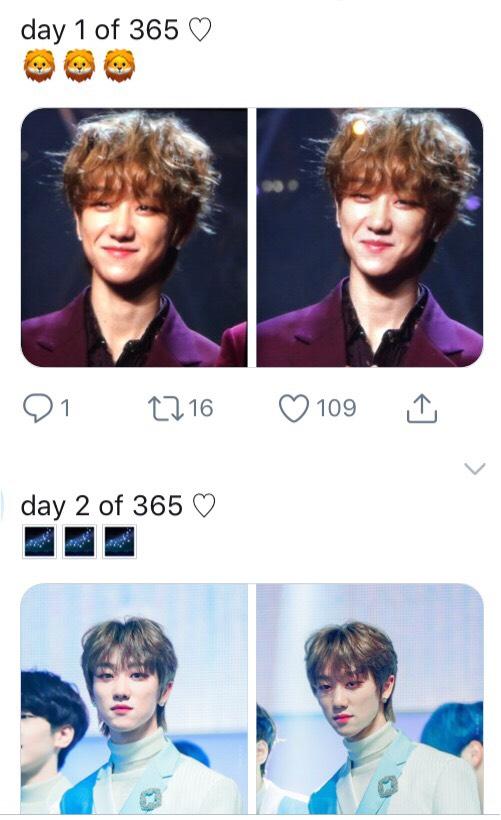
The first tweets of a “365 days with your ultimate” thread
This example shows the first tweets of a thread of pictures.
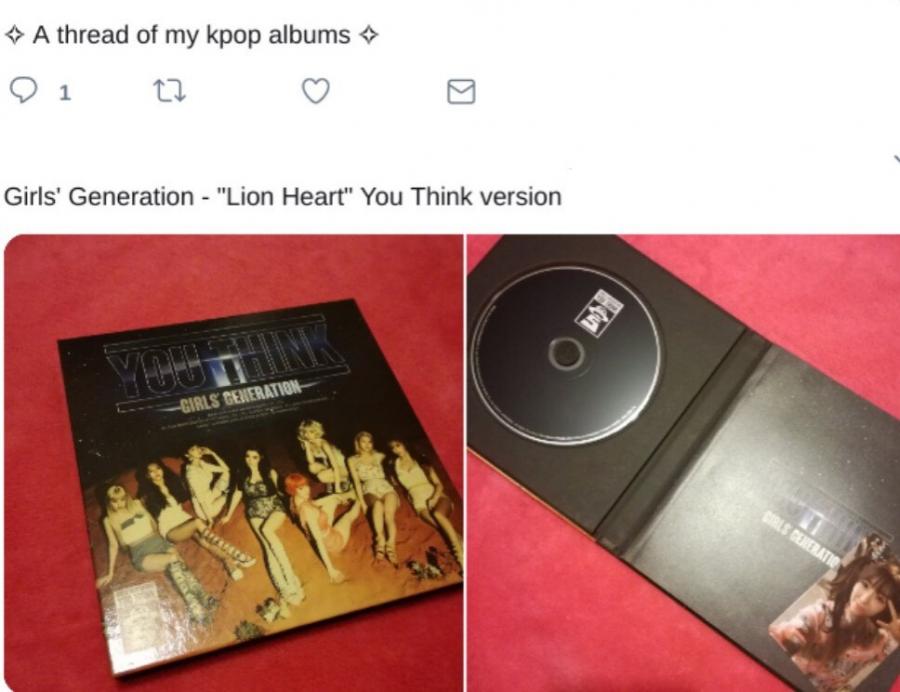
The first tweets of a thread displaying albums and photocards
Another thread many fans make is a thread of all the albums they have collected and the accompanying photo cards of their idols that come with these albums, as seen in the example. Most of the K-Pop albums are accompanied by a physical picture of one of the artists and the idea is that fans will try to collect all the photocards of their favorite idols by buying multiple copies of the album or by trading with their friends.

Photocards of K-Pop group Red Velvet
Purchasing these physical albums is more about collecting souvenir items and pictures than actually listening to the music
K-Pop albums thus differ a lot from western albums. Not only because K-Pop albums usually have more lavish packaging than western albums, but also because the K-Pop albums come with different photocards of artists, photo books with lots of pages and pictures, and other souvenir items. Purchasing these physical albums is thus more about collecting souvenir items and pictures than actually listening to the music.

K-Pop group f(x)’s album "Pink Tape"
The purple ribbon and the #BlackArmyBeauty project
One of the things that the K-Pop fandom is most known for is their fan projects. In particular fans of the K-Pop group BTS are known for organizing popular fan projects.
BTS wants to spread the ideals of self-confidence and being kind to others through their music, and their fans have taken it upon themselves to spread this message of love and kindness. They do this by organizing projects on social media. Twitter is a very popular platform for arranging these projects. Examples of their fan projects are the purple ribbon project and the #BlackArmyBeauty project.

Instructions for the Purple Ribbon project
The purple ribbon project started as a way to ensure the safety of K-Pop artists, but it quickly became more than that. Purple is an important color for the fans of BTS, as one of the members of the group told their fans that purple is the last color of the rainbow and it thus means that the group will trust and love their fans for a long time.
The project started when fans went to the airport that the members of BTS were arriving at to create barriers with purple ribbon. This way, the artists could safely pass through the airport without being attacked or mobbed by their fans.
Instructions that got handed around amongst participants of the Purple Ribbon project
The sharing of the purple ribbon is not only about the safety of the artists, but also about ensuring the safety and comfort of fans. The purple ribbon often gets passed around among fans at concerts as a reminder to respect and take care of their fellow fans.
Instructions for the #BlackArmyBeauty project
Another example of fans trying to spread the message of love and kindness is the #BlackArmyBeauty project. A K-Pop fan on Twitter who noticed her friend was getting anonymous racist messages started the #BlackArmyBeauty project to spread more positivity and reduce racism.
The hashtag was accompanied by a picture of a flower called Protea King, which symbolizes diversity and courage. By reposting the hashtag #BlackArmyBeauty and the picture of the flower, you could show your support for Black BTS fans. Black fans quickly started posting pictures of themselves with the hashtag to spread more positivity in the fandom.
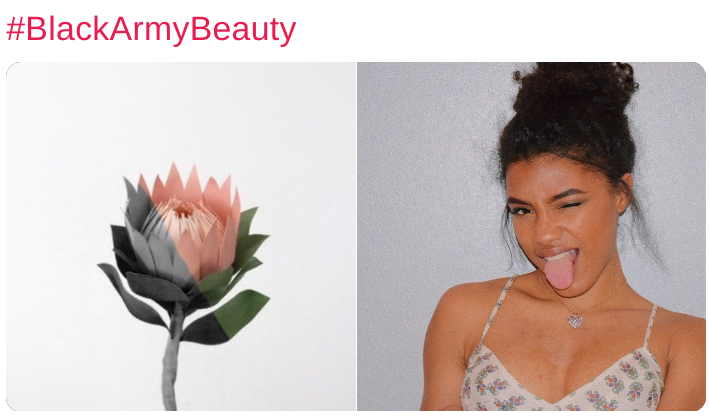
A fan participating in the #BlackArmyBeauty project
Commodification in the K-Pop industry
Commodification is a big part of fandoms and fan culture in the 21th century. Being a fan of your favorite idol or artist is about showing your support for them, and in practice this mostly comes down to going to concerts and buying their books or albums. Celebrities are very aware that they make money through the financial support of their fans, and the same applies in the K-Pop music industry.
K-Pop artists are very aware that they are, above all, a product that has to be sold. For example the artists are filmed a lot, not only during interviews and talk shows but also backstage, and they are very mindful of this. This means that the artists are always trying to sell a public, highly commercialized persona. Members of the K-Pop group BTS even refer to these personas as their own “characters”.
In Indonesia, the influence of K-Pop has now reached beauty and fashion and, in particular, children’s fashion. Clothing that stems from Korea has recently become very popular, not only because of the popularity of K-Pop artists, but also because the clothing is more affordable than international brands. In the Philippines, Magnum Ice Cream even launched Magnolia K-Pop ice cream due to the influence of K-Pop.
The more integrated fans are in the scene, the more they contribute to profits
The presence of commodification can also be found in, for example, the selling of the albums with multiple souvenir items. This also shows that the more integrated fans are in the scene, the more they contribute to profits. The more “hardcore” fans will try to collect all the different collectibles that come with an album, and by doing so they are spending more and more money on artists.
On top of that, most K-Pop artists have their own shops where they sell their clothing and merchandise. The more integrated a fan is, the more they will want to consume their favorite artist’s merchandise.
The K-Pop fandom as outsiders
Although K-Pop is getting more and more popular everyday and most of its fans can be found all over the Internet at this point, there are some people who are unhappy with the increasing success of K-Pop stars.
On a forum for unpopular opinions about K-Pop, a Reddit user posted that they hate K-Pop and one of the reasons was the fandom:
“I also hate the fan base. Just one word of you saying that you hate kpop, they’re gonna say all the mean things to you. Well, MOST of them do. I think they’re too crazy and obsessed towards kpop and they treat it as if it’s the only thing in life. (Well, that’s what I’ve observed)”
The user also expressed their incredulity at the merchandise in the K-Pop industry. They added:
“I think the merch is crazy too. These fans go crazy on the pictures of their Idols on plastic cards and other merch that costs waaaay too much.”
It seems that this hatred is mostly targeted at K-Pop fans on Twitter, as a different user replied saying:
“Twitter is especially intoxicated with their crazy fan base smh”
It is not just Reddit users who speak ill of K-Pop fans. In South-Korean culture, there is even a term for an over-obsessive fan of a Korean idol, known as a sasaeng. In general, sasaengs are known to be female fans who commit illegal crimes in order to get their idol’s attention, such as stalking or stealing.
The K-Pop fandom is only getting bigger, but this comes with a lot of criticism from people outside of the fandom. These people do not understand the fans’ norms, customs and habits. They call them crazy and obsessed for spending so much money on merchandise. K-Pop fans can thus also be considered outsiders, as people from outside the fandom consider most of their actions to be strange and abnormal.
K-Pop fandom as a niched culture
The K-Pop fandom can be seen as a niched culture on Twitter. However, whereas other fans simply have to have a themed layout and tweet about their fandom, the construction of identity as a K-Pop fan is more complex and difficult.
Without understanding the terms, names and words that are frequently used by K-Pop fans, you cannot become a full member of the fandom. To become part of this community, you have to do your research first.
There is, however, a large collection of websites and blogs that can help new fans on their way. Not only vocabulary, but also traditions and habits, such as the Selca Days, set K-Pop fans apart on Twitter. There might be some people who would disagree, but the K-Pop fandom is one of the most powerful fandoms on Twitter because of organized mass traditions and actions.
References
Anonymous (2018) BTS Fans “Purple Ribbon Army” Project Gains Applause From Korean Netizens
Becker, H. (1963) Outsiders
Dahir, I. (2018) This BTS Fan Created A Project To Empower Black Fans And People Are Loving It
Gordon, L. (2015) Riding the Korean Wave: How K-Pop, K-Drama and K-Beauty are Influencing Consumers
Maly, I & Varis, P. (2016) The 21st century hipster: on micro-populations in times of super-diversity
Samuelson, H. (2017) The Philosophy of BTS: K-Pop, Pop Art, and the Art of Capitalism
Sun-hwa, D. (2018) When K-Pop superfans turn ugly - the dark side of the Korean pop culture phenomenon, where admiration turns to obsession
Tucci, S. (2016) K-pop A to Z: A beginner’s dictionary
Varis, P. (2016) Digital ethnography
Vertovec, S. (2006) Super-diversity